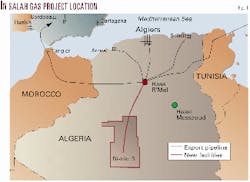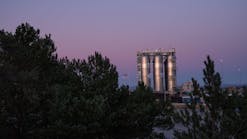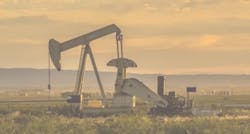In the year 2003, a new gas province will come on stream when gas production commences from the fields of the In Salah Gas Project in District 3 area of central Algeria.
The In Salah Gas Project is a partnership between Sonatrach and BP that involves joint activities in a fully integrated upstream and downstream gas business including exploration, appraisal, development, transportation, and gas marketing.
The framework for the joint activities of the In Salah Gas Project is the Contract of Association between BP and Sona- trach that came into force in February 1997 after approval by the Algerian Ministry of Energy & Mines. The contract envisages three major phases:
- The phase of exploration and appraisal comprising seismic, drilling, testing operations, and engineering studies during February 1997 to February 2000.
- The phase of development comprising pipeline and facilities construction and drilling, leading to delivery of first gas scheduled for 2003.
- The phase of operations starting in 2003 when gas will be produced from In Salah Gas and exported via Hassi R'Mel to meet sales contracts in southern Europe that extend for up to 15 years. Production is expected continue until the end of the contract in February 2027.
The contract created joint Sonatrach and BP teams for both operations and gas marketing activities-respectively, L'Organe des Operations Conjointes (OOC) based in Hassi Messaoud and in London and the joint marketing company (In Salah Gas) based in The Hague.
The joint teams reported regularly to the Sonatrach/BP management board in order to prepare a development plan which is both consistent with the expected gas sales to southern Europe and which meets the demands of the two shareholders in terms of economic return and assurance of delivery.
The OOC submitted a development plan in November 1999 to meet the In Salah Gas marketing expectations for gas sales contracts to deliver a total of 9 bcm/year to customers in southern Europe. The major challenge has been to demonstrate to the shareholders Sonatrach and BP a high level of assurance in ability to deliver the In Salah Gas Project and fully meet the commitments to HSE, quality, planning, budget, and Algerian content.
Exploration, appraisal history
The In Salah gas fields are located in District 3, a region of the Algerian Sahara not yet exploited for hydrocarbon production (Fig. 1).
Numerous gas fields have been discovered there since the first discovery in 1956, but no hydrocarbons have been developed to date on account of the remoteness of District 3 from existing infrastructure.
The Contract of Association between Sonatrach and BP provided access to two types of concession in District 3, an exploration area of interest and also the delineated areas around 7 nominated fields (in total 23,445 sq km).
The 7 fields at In Salah had established productive zones for gas in Devonian and Carboniferous reservoirs.
The Contract of Association committed the joint operations team to complete an exploration and appraisal program during February 1997 to February 1999 comprising the acquisition of 2,000 line km of 2D seismic and 750 sq km of 3D seismic data and drilling of 4 exploration and 5 appraisal wells.
The joint operations team worked closely with the ministry in order to define the overall shape of the program including the series of four extended well tests during 1998.
The seismic acquisition program was successfully completed during the second and third quarters of 1997, supported from the new In Salah Gas Base de Vie constructed at Hassi Messaoud.
Two drilling rigs were engaged, and drilling operations began in October 1997. A third rig suitable for workover operations was engaged in January 1998 to carry out well testing.
By February 1999 the 4 exploration wells in the exploration area of interest and the 5 appraisal wells in the three northern fields had been completed together with testing operations including four extended well tests (EWTs) and four drillstem tests (DSTs).
Updating information
The comprehensive data acquisition program for the well operations furnished an excellent set of new core, log, and test data. The EWT data showed widespread drainage areas within the Devonian reservoirs of Teguentour and Reg fields and provided the basis for a significant reduction in development well numbers.
The interpretation of exploration drilling and testing results established the presence of modest new volumes of gas which will be the subject of further delineation before incorporation into the In Salah Gas Project.
The interpretation of appraisal drilling and testing results in conjunction with the seismic and existing well data provided the basis for updating the in-place estimates, reserves, and profiles for the three northern fields. By analogy with these studies on the northern fields together with interpretation of the existing well and seismic data for the four southern fields, the in-place estimates, reserves, and profiles for the four southern fields were similarly revised.
The total reserve from the 7 fields is estimated at 7.5 tcf net sales gas with potential for future additions. The In Salah Gas production profile will deliver 9 bcm/year to meet sales gas contracts that extend for up to 15 years from first gas in 2003 (Fig. 3).
During this phase of operations the joint operations team demonstrated a strong improvement in both safety performance and in drilling times and costs for operations. The operational experience gained during this period combined with the more detailed well engineering studies carried out during the conceptual, front-end engineering design (FEED), and pre-sanction phases provide the basis for detailed definition of the development drilling program and costs.
Contractors, engineering
The joint association also undertook extensive engineering studies of increasing levels of technical definition.
Kellogg/JGC, London, handled conceptual engineering in fourth quarter 1997 and first quarter 1998 and FEED in second half 1998-first half 1999.
The key contractors for the pre-sanction engineering studies in fourth quarter 1999-first quarter 2000 were selected to be:
- Kellogg/Brown & Root/JGC, gathering systems, facilities, and infrastructure.
- Bechtel, main export and interfield pipelines.
- Deco, drilling rig supply.
- ENSP/Baroid, drilling fluids.
- Sperry-Sun, directional/performance drilling.
Among these selected contractors is a significant content of Algerian contractors. The selected contractors for the presanction engineering worked with representatives from the joint operations team to provide further technical definition and costs together with the necessary elements of assurance required by the shareholders.
Development concept
The project is based upon the development of the 7 fields Krechba, Teguentour, Reg, Garet el Befinat, Hassi Moumene, In Salah, and Gour Mahmoud (Fig. 2) plus the Boutraa gas discovery as an additional field for later development.
Initially the three northern fields Krechba, Teguentour, and Reg will be developed to deliver the sales gas profile from first gas in August 2003. Subsequently when deliverability declines from the first three fields the pipeline will be extended southwards from Reg to enable the development of Gour Mahmoud, In Salah, Garet el Befinat, and Hassi Moumene. The Boutraa gas discovery provides an additional option for development in this phase.
The development program calls for 70-75 re-entries and new wells plus 12 horizontal drainholes to be drilled in the 7 fields. At first gas the count will be 25-30 wells plus 2 horizontal drainholes based on a profile of 9 bcm/year.
Gas processing
Gas produced will be gathered and processed through surface facilities capable of delivering sales gas to tie-in at the Hassi R'Mel Centre National de Distribution (CNDG) infrastructure to meet the gas specification. Each field will have a flowline network for the untreated reservoir fluids. These networks will be corrosion resistant due to the presence of free water and CO2.
Flow lines will be added as additional wells are completed in each field. Each field will have liquid removal facilities and gas drying. A network of interconnecting pipelines sized from 16 in. to 38 in. will transport gas from each field to Krechba.
Krechba will be the primary processing and compression center as well as the site for removal of CO2 before drying and export via the main 48 in. export pipeline to Hassi R'Mel. The extracted CO2 will be compressed and re-injected north of Krechba field.
Initially the gas will free-flow from Krechba into the export line, and compression will be required at Krechba when wellhead flowing pressure drops below 86 bar. The operations will be managed from Hassi Messaoud but with the main operating centre at Krechba and permanent operating facilities at Hassi R'Mel, Krechba, Teguentour, Reg, and In Salah. The facilities for Garet el Befinat and Hassi Moumene will be normally unattended.
The FEED costs estimated for the development concept have been refined further during the presanction engineering phase to incorporate the results of cost reduction initiatives-variously scope revisions and efficiencies in the project execution through procurement, contracting strategy, logistics, and infrastructure benefits.
In addition, potential benefits from synergies between In Salah Gas and other BP projects in Algeria have been taken into account. It is expected these costs will be reduced towards the target cost numbers as the contracts are negotiated for the execution phase.
Project execution, operations
Seismic crews probe the Algerian Sahara for indications of more gas in the BP/Sonatrach In Salah project. Photos courtesy of BP Photographic Services 2000.
The project schedule for activities up to first gas comprises construction of the export pipeline, field facilities, and wells for the 3 northern fields including inter-field pipelines, gathering systems, and infrastructure. The project schedule for later phases of development work comprises infill drilling in the northern fields, installation of export compression, pipeline and facilities construction, and wells for the four southern fields.
The In Salah Gas Project is located in a remote area of the Sahara, and new infrastructure will be required during the construction and operations phases. Where possible use will be made of existing airports, roads, and accommodation as wells as existing Sonatrach facilities at Teguentour and Hassi R'Mel. New roads where required will follow as closely as possible the pipeline right of way.
The authors
Said Aktreche is director of exploitation and conservation for the Ministry of Mines and Energy in Algiers.
Said Sahnoun is director of associations with BP responsible for Sonatrach's interest in the Sonatrach-BP In Salah and In Amenas joint ventures. He was previously technical director of In Salah as manager of the joint BP and Sonatrach technical teams.
O. Maaliou is gas marketing manager with Sonatrach in Algiers.
John Martin is president of the joint BP-Sonatrach team on the In Salah project. He is based in Sunbury, England.
John Pooler is reservoir manager for the Rhourde El Baguel field EOR project (Sonarco Team) in Algeria. He was previously reservoir manager for the In Salah project. He was reservoir manager of the North Sea ETAP fields development before joining the Algeria projects in 1997. E-mail: [email protected]







